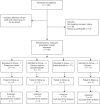Evaluation and comparison of efficacy of three desensitizing dentifrices on dentinal hypersensitivity and salivary biochemical characteristics: A randomized controlled trial
- PMID: 28584540
- PMCID: PMC5443011
Evaluation and comparison of efficacy of three desensitizing dentifrices on dentinal hypersensitivity and salivary biochemical characteristics: A randomized controlled trial
Abstract
Background: This study aimed to evaluate and compare the efficacy of three desensitizing dentifrices on dentinal hypersensitivity (DH) and salivary biochemical characteristics.
Materials and methods: A randomized, parallel arm, triple-blinded, clinical trial was conducted over a period of 12 weeks, with a total of three visits: baseline, 6 weeks, and 12 weeks. Calcium sodium phosphosilicate, potassium nitrate and amine fluoride dentifrices were compared. A total of 68 subjects who satisfied the inclusion criteria were included and randomly divided into four groups. Visual analog scale scores for controlled air stimulus were used to assess dentinal sensitivity and salivary pH and buffering capacity were recorded at baseline, 6 and 12 weeks.
Results: All groups showed a reduction in sensitivity scores at 6 and 12 weeks. The calcium sodium phosphosilicate group showed a higher degree of effectiveness in reducing DH than potassium nitrate, amine fluoride dentifrices, and placebo for sensitivity measures. Salivary pH of calcium sodium phosphosilicate group was more toward neutral, and the buffering capacity of the same group showed significant changes from baseline to 6 and 12 weeks compared to the other groups.
Conclusion: The desensitizing toothpaste containing calcium sodium phosphosilicate was found to be more effective in reducing DH and showed improvement in salivary biochemical characteristics over a period of 12 weeks compared to others.
Keywords: Amine fluoride gel; Hydrogen ion concentration; calcium sodium phosphosilicate; potassium nitrate; saliva; sodium bicarbonate capacity; toothpastes.
Conflict of interest statement
The authors of this manuscript declare that they have no conflicts of interest, real or perceived, financial or nonfinancial in this article.
Similar articles
-
[Effect of calcium sodium phosphosilicate and potassium nitrate on dentin hypersensitivity: a systematic review and Meta-analysis].Hua Xi Kou Qiang Yi Xue Za Zhi. 2018 Jun 1;36(3):301-307. doi: 10.7518/hxkq.2018.03.014. Hua Xi Kou Qiang Yi Xue Za Zhi. 2018. PMID: 29984933 Free PMC article. Chinese.
-
Comparative evaluation of a dentifrice containing calcium sodium phosphosilicate to a dentifrice containing potassium nitrate for dentinal hypersensitivity: A clinical study.J Indian Soc Periodontol. 2014 Sep;18(5):581-5. doi: 10.4103/0972-124X.142447. J Indian Soc Periodontol. 2014. PMID: 25425819 Free PMC article.
-
Comparative Evaluation of Desensitizing Efficacy of Dentifrice Containing 5% Fluoro Calcium Phosphosilicate versus 5% Calcium Sodium Phosphosilicate: A Randomized Controlled Clinical Trial.Contemp Clin Dent. 2018 Jul-Sep;9(3):330-336. doi: 10.4103/ccd.ccd_735_17. Contemp Clin Dent. 2018. PMID: 30166822 Free PMC article.
-
A clinical study of the effect of calcium sodium phosphosilicate on dentin hypersensitivity.J Clin Exp Dent. 2013 Feb 1;5(1):e18-22. doi: 10.4317/jced.50955. eCollection 2013 Feb 1. J Clin Exp Dent. 2013. PMID: 24455046 Free PMC article.
-
Effect of desensitizing toothpastes on dentine hypersensitivity: A systematic review and meta-analysis.J Dent. 2018 Aug;75:12-21. doi: 10.1016/j.jdent.2018.05.012. Epub 2018 May 19. J Dent. 2018. PMID: 29787782
Cited by
-
Solidago virgaurea L. Plant Extract Targeted Against Candida albicans to Reduce Oral Microbial Biomass: a Double Blind Randomized Trial on Healthy Adults.Antibiotics (Basel). 2020 Mar 25;9(4):137. doi: 10.3390/antibiotics9040137. Antibiotics (Basel). 2020. PMID: 32218125 Free PMC article.
-
Efficacy of bioactive glass-based desensitizer compared to other desensitizing agents or techniques in dentin hypersensitivity: a systematic review.BMC Oral Health. 2025 Jun 3;25(1):899. doi: 10.1186/s12903-025-06288-5. BMC Oral Health. 2025. PMID: 40462050 Free PMC article.
-
Improving Oral Health with Fluoride-Free Calcium-Phosphate-Based Biomimetic Toothpastes: An Update of the Clinical Evidence.Biomimetics (Basel). 2023 Jul 27;8(4):331. doi: 10.3390/biomimetics8040331. Biomimetics (Basel). 2023. PMID: 37622936 Free PMC article. Review.
-
Evaluation of the effectiveness of fluoridated and non-fluoridated desensitizing agents in dentinal tubule occlusion using scanning electron microscopy. An in-vitro study.Dent Res J (Isfahan). 2020 May 23;17(3):193-199. eCollection 2020 May-Jun. Dent Res J (Isfahan). 2020. PMID: 32774796 Free PMC article.
-
[Effect of calcium sodium phosphosilicate and potassium nitrate on dentin hypersensitivity: a systematic review and Meta-analysis].Hua Xi Kou Qiang Yi Xue Za Zhi. 2018 Jun 1;36(3):301-307. doi: 10.7518/hxkq.2018.03.014. Hua Xi Kou Qiang Yi Xue Za Zhi. 2018. PMID: 29984933 Free PMC article. Chinese.
References
-
- Holland GR, Narhi MN, Addy M, Gangarosa L, Orchardson R. Guidelines for the design and conduct of clinical trials on dentine hypersensitivity. J Clin Periodontol. 1997;24:808–13. - PubMed
-
- Brännstrom M, Lindén LA, Johnson G. Movement of dentinal and pulpal fluid caused by clinical procedures. J Dent Res. 1968;47:679–82. - PubMed
LinkOut - more resources
Full Text Sources

